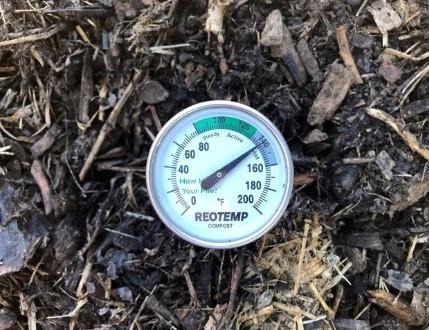What is Composting?
Composting is a process through which organic materials made up of nitrogen and carbon break down into nutrient-rich humus that gardeners might otherwise buy with cash that could instead be spent on new plants or gardening gadgets. You can compost grass clippings. You can compost leaves. You can compost veggie and fruit scraps and coffee grinds, paper filter and all. You can compost a cotton shirt, though it might take about as much time as the jute burlap that found its way into my pile a year ago.
Finished compost has a relatively low nutrient value, especially compared to mineral and even other organic fertilizers. According to the University of Massachusetts Center for Agriculture, Food, and the Environment, compost has an analysis of 1-1-1, though that can vary, and only a fraction of its macronutrients like nitrogen will be available to plants. The reason is that the N, P, and K all require microbial and chemical activity to be released from the humus itself.
Even so, compost is at a minimum an outstanding mulch. Mulch is any material that covers bare soil, from rocks to wood chips to compost. Keeping the ground covered keeps down weeds, reduces how much soil runs off with the rains, and helps the soil stay cool and moist on central valley summer days that can evaporate a swimming pool. The advantage of using compost is that while it's less of a weed deterrent than something like wood chips or UV-resistant black plastic, it feeds the beneficial bacteria, fungi and worms that keep the soil fertile and healthy.
The benefits of composting reach even beyond having mulch for healthy plants. Composting at home diverts waste that may otherwise end up in the landfill, unless you have a green bin to set outside. UC Davis scientists found that adding composted soil amendments may even play a role in fighting climate change by sequestering carbon, though a tiny backyard patch offers little hope of single-handedly saving the world.
Speeding up the Process of Breaking Down with Compost
So how fast does composting happen? My next-door neighbor has a bin he's been adding table scraps, grass clippings and leaves to for a decade and the pile itself hasn't much changed in size. My experience has been similar these past two years. After Janet's online presentation last year and a generous phone conversation to build up my confidence, I grabbed the pitchfork and started turning over the pile.
Janet's idea of regularly turning over the compost pile is based on a rapid composting method developed by UC Berkeley plant pathologist Robert Raabe. With this method, you can make finished compost in two to three weeks if the conditions are ideal:
- Balanced nitrogen to carbon ratios of about 30:1
- Small pieces up to 1 ½ inches in size maximum
- 50 percent moisture content
- Temperature in the pile at about 160 degrees F
Let's say I did my best. Every other day I turned the pile from one side of the bin to the other. Incredibly, the pile shrunk noticeably every time. I was turning over less and less compost, and it was getting heavier and heavier.
It still wasn't quite breaking down. I bought a compost thermometer, which is really a lot like my soil thermometer but longer, and jabbed it into the pile. The first couple of times I refrained from turning the pile over to let the temperature rise, believing that the higher the temperature the more composting activity. In late November it took a full day to get from about 70 degrees to over 90, and two more days to touch 110.
That was about as hot as it would get before starting to cool. For another three months, I flipped the pile every few days. The pile got smaller and smaller but the temperature never got much higher than 110. Then I thought that maybe it was my nitrogen/carbon ratio that was off. I would add kitchen scraps to the pile every other day and an occasional layer of straw. Everything was certainly wet enough. Maybe there really weren't enough greens to make it cook.
Annual ryegrass produces a lot of organic material. It grows fast enough to need cutting every week before it gets completely out of hand. I'd been tossing this bulk into the city compost bin in the belief that I already had enough material to turn in my own backyard bins. I'll try it, I thought. I cut the lawn and added all of it to the pile. In two days I plunged the thermometer in and watched the needle climb to 140. Not quite the 160 I'd hoped for, but it would do.

I kept turning the pile. In May I added that compost to my planting bed and promptly jabbed in my summer crop of “bloody butcher” corn that I expect will provide a bounty.
Recently I mentioned all this to Janet, my compost guru. I told her how everything went all right but slow until I added grass clippings. She smiled and said, “You'd really be surprised what a difference it can make.”
Source : ucanr.edu